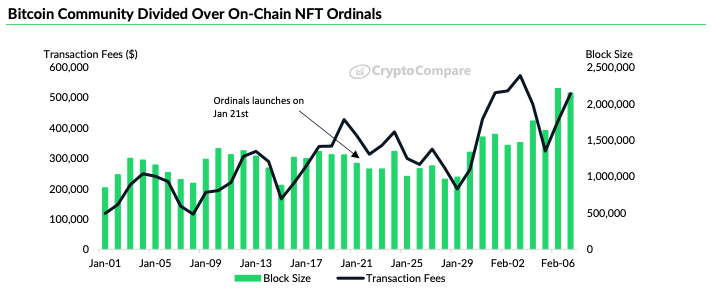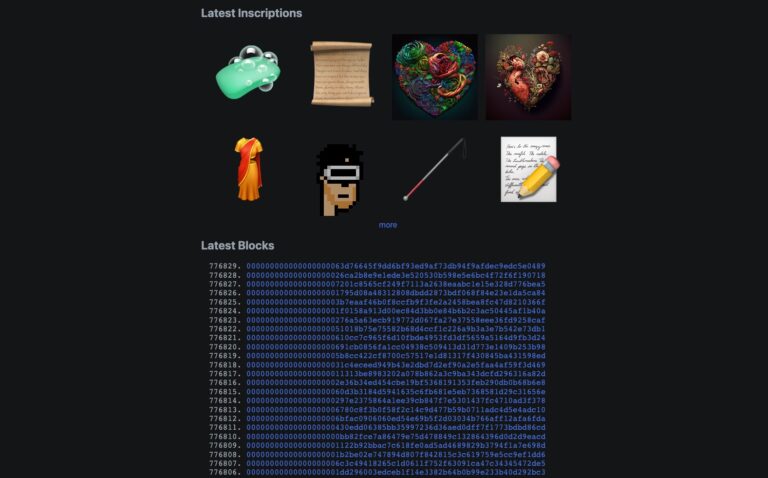On Thursday (16 February 2023), Dr. Muneeb Ali, who is the co-creator of Stacks, “an open-source platform to enable smart contracts, DeFi, NFTs, and apps for Bitcoin,” as well as Co-Founder and CEO of Trust Machines, commented on the currently hot topic of Bitcoin NFTs.
Earlier today, Dr. Ali had this to say about the Ordinals protocol, which supports on-chain Bitcoin-native NFTs.
Casey Rodarmor, the creator of the Ordinals project, who is a former Bitcoin Core contributor, said in a blog post published on 20 January 2023 that the Ordinals protocol supports putting “inscriptions” on the Bitcoin blockchain, and then went on to explain how inscriptions are different from NFTs:
“Inscriptions are digital artifacts native to the Bitcoin blockchain. They are created by inscribing sats with content using ord, and can be viewed with the ordinals explorer. They do not require a separate token, a side chain, or changing Bitcoin. Inscriptions are created by including content, like an image, text, SVG, or HTML, in an inscription transaction. The content is included in the transaction witness, which normally contains signatures and other data proving that a transaction is authorized. Along with the content, the inscription transaction contains a content type, also known as a MIME type, identifying the type of content to be inscribed…
“Inscriptions are digital artifacts, and digital artifacts are NFTs, but not all NFTs are digital artifacts. Digital artifacts are NFTs held to a higher standard, closer to their ideal. For an NFT to be a digital artifact, it must be decentralized, immutable, on-chain, and unrestricted. The vast majority of NFTs are not digital artifacts. Their content is stored off-chain and can be lost, they are on centralized chains, and they have back-door admin keys. What’s worse, because they are smart contracts, they must be audited on a case-by-case basis to determine their properties. Inscriptions are unplagued by such flaws. Inscriptions are immutable and on-chain, on the oldest, most decentralized, most secure blockchain in the world. They are not smart contracts, and do not need to be examined individually to determine their properties. They are true digital artifacts.“
On 7 February 2023, Binance Research said that “in recent weeks, the Ordinals protocol has gained widespread popularity, with users experimenting by embedding JPEGs, videos, and even PDFs onto the blockchain. It also mentioned that while some members of the Bitcoin community have raised concerns about the Ordinals protocol potentially driving up transaction fees by consuming block space on the Bitcoin network, there is an ongoing debate about whether this is a positive or negative development for the blockchain.
On the same day, independent developer and consultant Udi Wertheimer listed some of the benefits of Bitcoin NFTs:
On 14 February 2023, James Killick wrote an article for “Start With NFTs” that explained the differences between Stacks NFTs and Ordinals:
- “Inscriptions store all content immutably—rendering it impossible to remove any unauthorized or inappropriate material.
- When the transaction size increases, nodes may be required to pay higher fees and experience increased demands.
- As a consequence of the soaring acceptance of ordinals, the average block size has amplified, meaning greater fees per block. This could have an incredibly unfavourable impact on the Bitcoin community if it continues to grow exponentially.
- The recent NFTs and media on Bitcoin have already taken up a shocking 500 megabytes of storage, costing creators over 6 BTC (around $155K) in no time. That’s an incredible amount of money for such little memory!“
CryptoCompare’s latest Asset Report, which was released on 15 February 2023, had this to say about the impact of Ordinals on the Bitcoin network’s block size and transaction fees:
“The age-old debate over whether the Bitcoin blockchain should be used for functions other than financial transactions has been revived with the launch of a Bitcoin on-chain NFT protocol named Ordinals, which launched on January 21st. Using a design quirk in the Taproot upgrade, Ordinals allows digital assets such as images to be inscribed on Satoshis on the Bitcoin blockchain.
“Critics have argued that these inscriptions could delay the confirmation of other financial transactions as they occupy larger amounts of Bitcoin block space. The Bitcoin network has seen a steady increase in block size since the launch of Ordinals, recording an all-time high of 2.20 MB on the 6th of February. The blockchain has also seen a rise in transaction fees as a result, recording daily fees of $572k on the 3rd of February, the highest since November 2022.“










